One of the hottest categories of overlanding platforms is the midsize truck segment, which includes such stalwarts as the Chevy Colorado, Ford Ranger, and Toyota Tacoma.
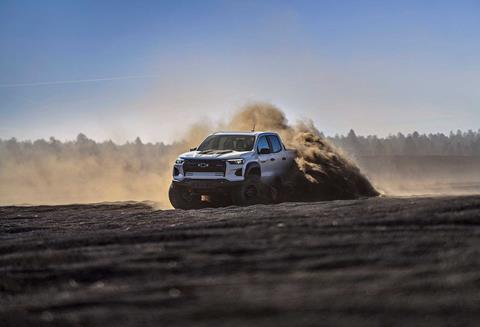
The current generation of these trucks have all been highly embraced by the aftermarket, and have incredible upfit potential for backcountry adventures. It just so happens that all three of three trucks are in the midst of a redesign for the ’23 and ’24 model years that is going to bring each of these trucks up to a competitive new standard.
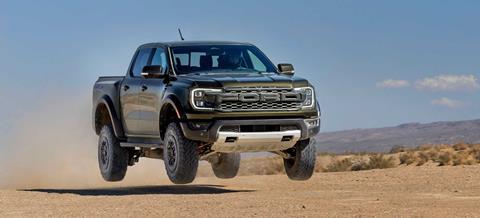
While we haven’t had a chance to get behind the wheel of these midsizers yet, we thought we would give you a brief overview of each pickup’s top off-roading trim and summarize the announcements that have been coming hot and heavy over the last couple of months. We’ll also take a look at how they stack up against one another on the spec sheet below.

This upcoming crop of trucks is arguably the most competitive field in the history of midsize pickups. Never before has this level of technology and capability been offered off the showroom floor and we can’t wait to start seeing these trucks out prowling the trails.
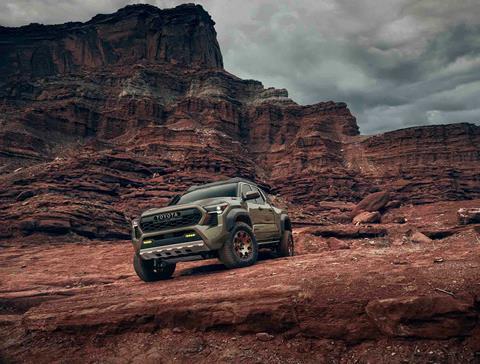
Chevy Colorado ZR2 Bison
Base Price: $62,000 (est.)
Available: Fall 2023
Read our First Drive of the Colorado ZR2 Bison here.
The current Chevy Colorado is available now, with the top off-road trim being the highly capable ZR2 that went into production in May. The ’23 ZR2 adds a tremendous amount of capability over the standard Colorado, starting with the highest-output version of GM’s 2.7L turbocharged four-cylinder engine making 310 horsepower and 430 lb-ft of torque, backed by an 8-speed automatic transmission.
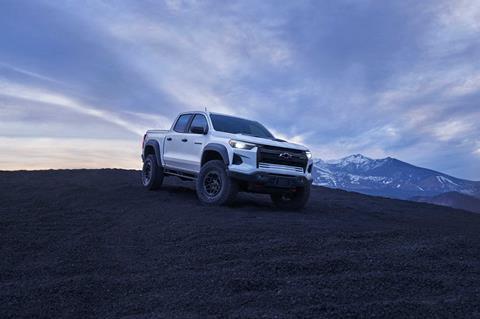
Of course, four-wheel drive is standard, as are front and rear lockers, 33-inch tires on 17-inch wheels, and updated versions of the excellent Multimatic DSSV shocks. The ZR2 also adds aluminum skid plates under the front crossmember and a steel skid plate under the transfer case (no fuel tank skid plate) as well as factory rock rails.
Off-road technologies include new drive modes (Normal, Tow/Haul, Off-Road, Terrain, and Baja) and a host of cameras. The one-year-only Desert Boss accessory package adds a winch-capable steel bumper with a goofy grille guard, upgraded fog lights, beadlock-capable wheels, and a sport bar at the front of the bed that holds a light bar.
As cool as the ZR2 is, those in the know will wait for the ’24 Chevy Colorado ZR2 Bison, which continues the co-branding exercise Chevy started with American Expedition Vehicles (AEV) on the previous generation Colorado ZR2 Bison.
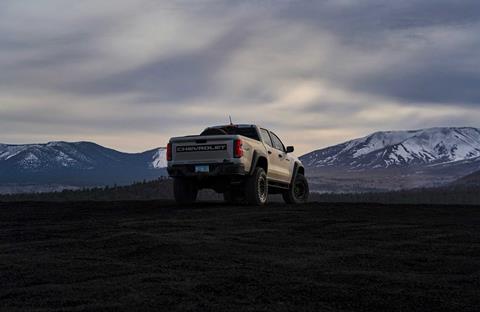
Checking the Bison box nets you everything from the standard ZR2, plus front and rear Multimatic hydraulic jounces for insane out-of-the-box high-speed performance, five hot-stamped Boron steel skid plates that gives the Bison full underbody coverage, AEV-designed underbody cameras, special AEV 17-in beadlock-capable wheels, and oversized flares.
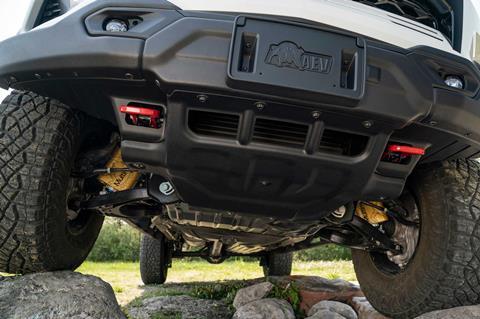
Those oversized flares cover a first-in-class 35-inch tire package, which deliver an impressive win over everything else in the midsize market, soundly trouncing the field with 12.2-inches of ground clearance (1.5-inches more than the standard ZR2). Despite the larger tires (and thanks to a half-inch body lift), the Bison retains the same 9.9-inches of front travel and 11.6-inches of rear travel as the standard ZR2. With the Bison, the 35-inch spare tire is now mounted upright in the bed.
Bisons also get AEV-developed steel front and rear bumpers, with the front one being winch capable. Burley front and rear tow points are ready for extractions and the styling is completely integrated into the Colorado’s design. In addition to exterior AEV branding, the interior gets AEV logo embroidered into the headrests, yellow contrast stitching, and yellow seat belts. The bigger 11.3-inch touchscreen is standard.
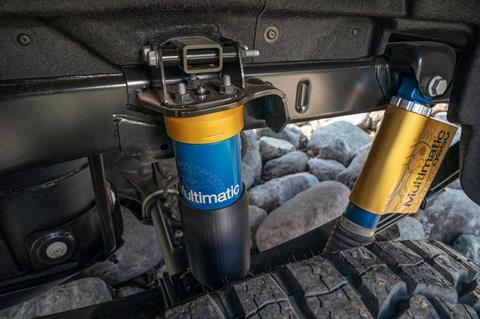
The standard ZR2 payload comes in at 1,151 pounds, while the Bison models see a payload decrease to 1,050 pounds and a 500-pound reduction in tow rating. While the payload looks low on the Bison, remember that this is after all the upgrades, such as the 35-inch tires, bumpers, and skid plates are considered. To make an apples-to-apples comparison to a competitor, you would have to subtract the weight of bumpers, skid plates, and 35-inch tires that you might want to add in the aftermarket to get a more accurate value.
Ford Ranger Raptor
Base Price: $56,900
Available: Summer 2023
Finally! The Raptorized Ranger has been announced for these shores as a ’24 model based on the new Ranger T6 platform, shared with the Bronco. This is one truck that many of us have been hotly anticipating, as Ford has sold a global version of the Ranger Raptor around the world since 2018. If you are a fan of the F-150 Raptor and were looking for similar capability in a smaller package, you haven’t had anywhere to go within the Ford family.
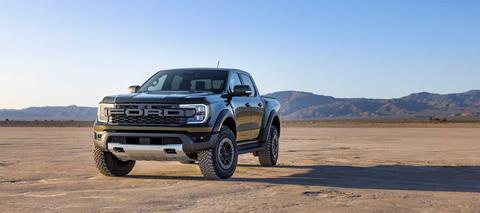
This all changes when the ’24 Ranger Raptor hits dealerships later this summer. While the Ranger Raptor’s Bronco Raptor platform mate comes to the trail with 37-inch tires, Ford has kept the focus for the Ranger on high-speed driving, and less about rock crawling, equipping the little pickup with 33-inch BF Goodrich All-Terrain KO3 tires and a noticeably lower 10.7 inches of ground clearance. The Ranger Raptor is sporting a wider track and unique bodywork and styling compared to the standard Ranger.
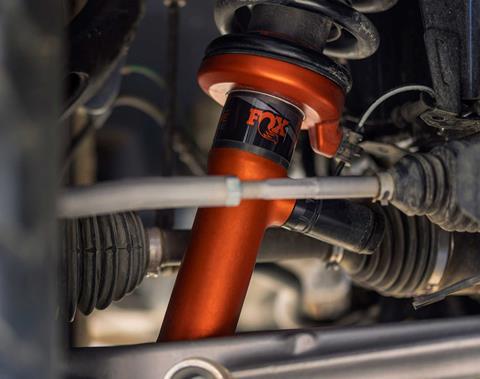
Like the Bronco, the Ranger gets 2.5-inch Fox Internal Bypass Shocks with Live Valve adaptive technology and jump detection. Rather than sticking with rear leaf springs like the Chevy and non-Raptor Ranger, Ford employs a rear axle with a Watts link for better handling, controlled by rear coilover versions of the front Fox shocks mounted outside of the frame rails. Wheel travel is right in line with the Colorado ZR2 Bison at 10 inches front and 11.5 inches rear, numbers that were unfathomable from a factory midsize truck just a few generations ago.
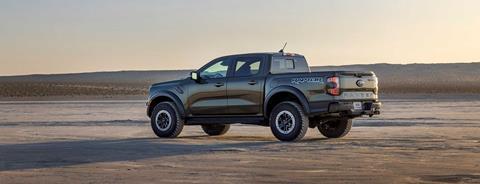
Like the Bronco, the Ranger Raptor is packing a 3.0L twin-turbo V-6 mated to a 10-speed automatic transmission, but at 405 horsepower and 430 lb-ft of torque, it is tuned for slightly less output when compared to the Bronco (418hp/440tq). It’s also about 400 pounds lighter, meaning that despite the small power deficit, it has a superior power-to-weight ratio.
Other Bronco Raptor technologies shared with the Ranger Raptor include drive modes (Normal, Tow/Haul, Sport, Slippery, Off-Road, Rock Crawl, and Baja - an “R” mode allows for tailoring of specific parameters outside the predefined drive modes), full underbody skid plating, an X-pipe performance exhaust with modes, a non-winch capable front steel bumper, a high clearance rear steel bumper, front and rear lockers, Trail Control, Trail Turn Assist, and a suite of cameras.

The interior of the Ranger Raptor is exactly what you would expect from a member of the Raptor line-up, with body-hugging bolsters on the front seats and bright Code Orange contrasting colors, Raptor branding elements, six upfitter switches, and steering wheel controls. A 12.4-inch vertical touchscreen is also standard.
The Ranger Raptor looks to be a real competitor in this space and with an impressive 1,411 pounds of payload, you won’t have to choose between your gear and your friends.
’24 Toyota Tacoma Trailhunter and TRD Pro
Base Price: TBA
Available: Early 2024
If people in the overlanding community are excited about the Raptor, they must be ecstatic about the ’24 Tacoma which was recently announced. The Tacoma, which hasn’t had a full redesign since 2005 (no, your updated engine, dash, and grille don’t count), was getting long in the tooth and despite class-leading sales, was one of the least exciting midsize choices on the market. The sins of being neglected for so long, such as a C-Channel rear frame and inexcusable drum rear brakes, have been atoned for in an all-new chassis that features a fully boxed frame and yes, even rear discs.
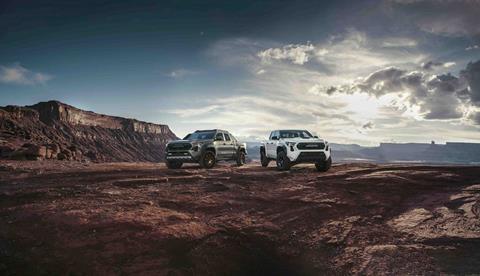
The new Tacoma shares it’s GA-F platform with its big brother Tundra, which gives us a pretty good idea about capability and ride and handling. The chassis has been developed to be lightweight and strong, while retaining the solid rear axle, moves to a multi-link coil-sprung rear suspension. Front suspension consists of double wishbones and coil springs.
Powertrains are the i-FORCE 2.4L turbocharged four-cylinder with 278 horsepower and 317 lb-ft of torque, backed by either a six-speed manual (!) or eight-speed automatic. The premium engine, which will be the sole engine available for top line trims is the i-FORCE MAX 2.4L turbocharged four-cylinder hybrid with combined 326 horsepower and 465 lb-ft of torque. The electric motor makes up for 48 horsepower and 184 lb-ft of torque of that number, fed by a 1.87kWh NiMH battery pack. The hybrid i-FORCE MAX is only available with the eight-speed automatic.
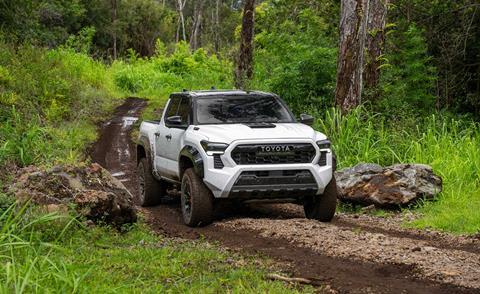
Styling is right in line with the Tundra, looking exactly how you would expect a Tacoma to look, athletic, purposeful, with no surprises. Two body styles are available, a two-seat, two-door XtraCab and the four-door double cab, which can be had with either a five- or six-foot box. Thanks to the redesign, there is a seven percent increase in bed volume.
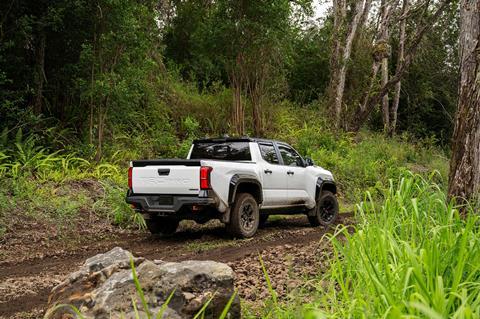
The modernization effort is continued in the cabin where you can find an optional 14-inch multimedia touchscreen with access to the available cameras, including ones that offer a new underbody view. The angular and chiseled dash is rugged and contemporary and the Tacoma offers plenty of cool little features, such as an optional center-mounted JBL FLEX speaker that can be removed from the dash and used as an exterior Bluetooth speaker and a QR code that is hidden on the driver’s side of the cabin that leads to plans for a variety of 3D printed accessories. Additional features include upgraded interior materials, a factory trailer brake controller, 360-degree camera views, and additional power outlets.
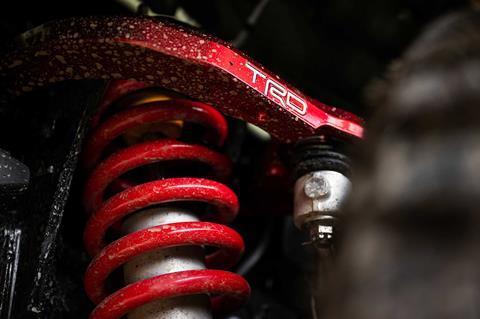
Off-road technologies have been improved, such as Multi-Terrain Select drive modes, which now functional in both high range and low, a quieter CRAWL control system, Downhill Assist Control (DAC), and available hill-descent control. Every Tacoma also comes standard with front recovery loops and an electronic rear locker is available, depending on trim.
It is clear that the Tacoma finally gets the chassis it deserves, and enthusiasts not only get a reinvigorated top-dog TRD Pro, but we also get the overlanding-centric Trailhunter. Each trim makes the most of the new Tacoma, but takes the truck in two completely different directions as far as use case goes.
So, let’s talk about what they share before we talk about how they differ. Both trims get oversized flares and the ARB-branded rear bumper with beefy recovery points. Both trucks get 33-inch tires and both trucks sit two-inches higher in the front and one-and-a-half-inches prouder in the rear than the base Tacoma. Other common upgrades include forged upper control arms, a grille-mounted RIGID 20-inch light bar, auxiliary switches, a 2400-watt AC inverter, a new-to-Tacoma electronically disconnecting front sway bar that allows for ten percent more suspension articulation, and a larger rear brake package.
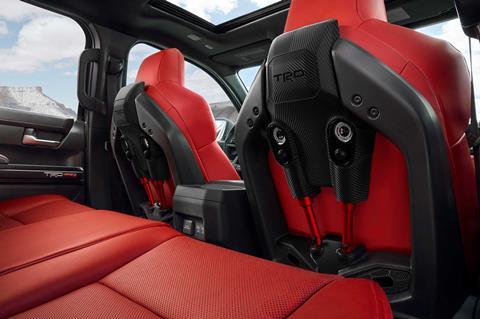
Toyota Tacoma TRD Pro
Geared for the go-fast crowd and aimed squarely at Ford’s Ranger Raptor, the TacomaTRD Pro steps up its game even further with this latest generation. At the heart of the Pro are 2.5-inch Fox Quick Switch 3 (QS3), three-position manual compression adjustable internal bypass shocks with remote reservoirs and FOX Internal Floating Piston (IFP) rear bump stops, built around the new multi-link rear suspension, to improve bottom out control over the most aggressive terrain. Anodized in red, the forged aluminum front TRD upper control arms provide eye candy and optimize front geometry while reducing unsprung weight. To augment stability, the TRD Pro is three inches wider than a standard Tacoma.
To really get you in that racing mood, Baja-inspired IsoDynamic suspension seats for the front row enhance driver comfort and minimizes fatigue in high adrenaline driving. These seats use ball joints and air-over-oil shocks to further soak up harsh terrain and they can be adjusted for the weight of the user and how aggressive the seats engage. The suspension mechanism can also be locked out, preventing any suspension action, for when the driver or passenger wants a more direct and traditional seat feel. The IsoDynamic thrones are also heated and cooled.
Other TRD Pro accouterments include a unique front fascia, white LED RIGID fog lights and a TRD cat-back dual-tip performance exhaust.
Toyota Tacoma Trailhunter
If the TRD Pro is the Samurai sword of the Tacoma lineup, the Trailhunter is the Swiss Army Knife. While much is shared with the TRDPro, there is certainly a different flavor to the Trailhunter with its more subdued bronze accents and more function-based upgrades.
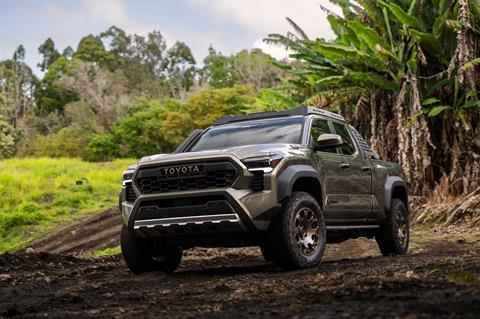
Starting with the suspension, the Trailhunter trades out the Fox shocks for Old Man Emu (OME) suspension that was co-developed with ARB and uses 2.5-inch position-sensitive forged monotube shocks with external piggyback style remote reservoirs in the rear. The suspension includes a forged upper control arm and is tuned for optimum levels of off-road control and load carrying capability.
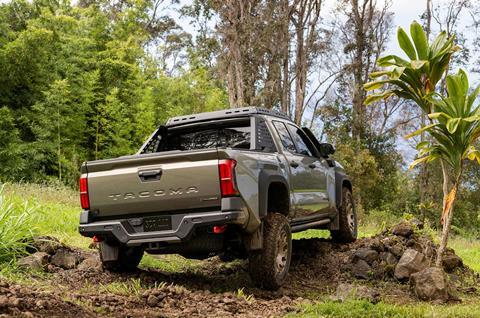
The Trailhunter is immediately noticeable in a crowded parking lot of Tacomas. The Toyota flat-pack style roof rack is obvious, as is the utility bar at the front of the bed that has integrated MOLLE panels and the A-pillar-mounted (don’t call it a snorkel) elevated air intake. Other giveaways include the factory rocker protection, high-tuck exhaust, and the white/amber color switching RIGID LED fog lights.
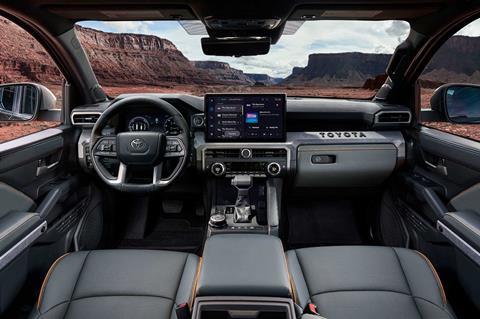
Adventurers will also appreciate the fact that the Trailhunter is equipped with a factory on-board air system and a full complement of hot-stamped skid plates. Light- or heavy-duty bed racks from ARB will also be on the option sheet.
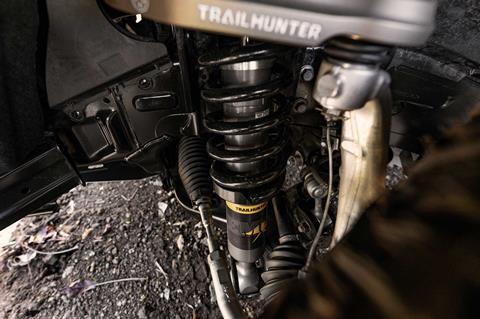
While both the TRD Pro and Trailhunter are designed to serve specific markets, we have to be honest, we are a bit torn as to whether we would choose the TRD Pro or the Trailhunter to build as our next adventure vehicles. Each truck has its strengths and the fact that both are equally desirable is a testament to Toyota’s team and how they fully appreciated their customer base with this redesign.
Midsize Madness
It is a pretty exciting time to be in the market for a midsize truck and we have yet to touch on some of the lesser trims that would still make for great overlanding rigs. What’s amazing is that the midsize market was all but dead ten years ago, and here we are today enjoying a renaissance of epic proportions. No matter which truck you are eyeing for your next rig, you wouldn’t be able to pick a bad one out of this group.
Quick Specs
| ’24 Chevy Colorado ZR2 Bison CC SB 4x4 | ’24 Ford Ranger Raptor CC SB 4x4 | ’24 Toyota Tacoma Trailhunter CC SB 4x4* | ’24 Toyota Tacoma TRD Pro CC SB 4x4* | |
|---|---|---|---|---|
|
Engine/Trans |
HO 2.7L turbocharged I4/8-speed Auto |
3.0L twin-turbo V-6/10-speed Auto |
2.7L turbocharged I4 hybrid/8-speed Auto |
2.7L turbocharged I4 hybrid/8-speed Auto |
|
Horsepower/Torque (lb-ft)
|
310/430 |
405/430 |
326/465 |
326/465 |
|
Wheelbase (in.)
|
131.4 |
128 |
132 |
132 |
|
Tire Size
|
LT315/70R17 |
P285/79R17 |
265/70R18 |
265/70R18 |
|
Wheel Travel F/R (in.)
|
9.9/11.6 |
10.0/11.5 |
TBA |
TBA |
|
Approach/Breakover/Departure Angles (degrees) |
38.2/26.9/26.0 |
33/24.2/26.4 |
33.8/23.5/25.7 (w/o tow package) |
33.8/23.5/25.7 (w/o tow package) |
|
Ground Clearance (in.)
|
12.2 |
10.7 |
11.0 |
11.0 |
|
Curb Weight (lbs.)
|
5,265 |
5,325 |
TBA |
TBA |
|
Payload (lbs.)
|
1,050 |
1,411 |
1,500 (est.) |
1,500 (est.) |
|
Towing (lbs.)
|
5,500 |
5,150 |
6,000 (est.) |
6,000 (est.) |
*Some of the information has not been released as of publication or are pre-production numbers and could change slightly, so our best effort has been made to be accurate.
Access More Great Stories!
This article originally appeared in OVR Issue 04. For more informative articles like this, consider subscribing to OVR Magazine in print or digital versions here. You can also find the print edition of OVR at your local newsstand by using our Magazine Finder.


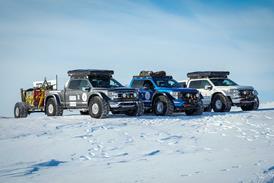

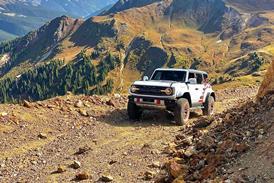

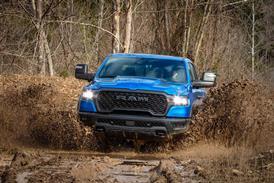
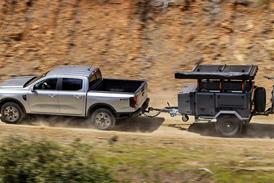

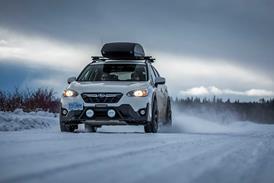

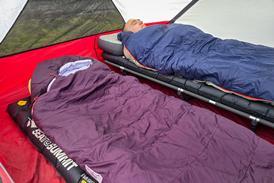

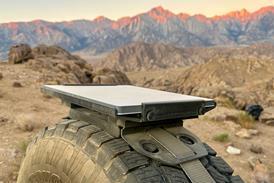
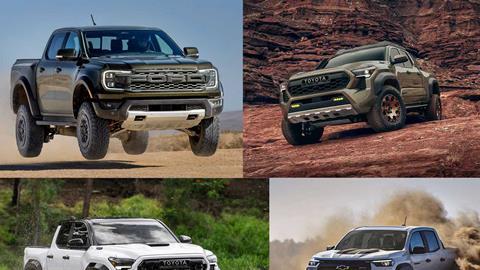






No comments yet